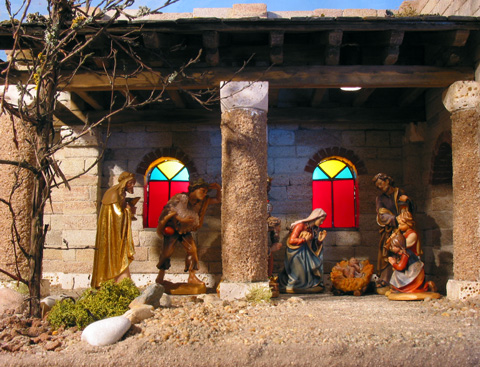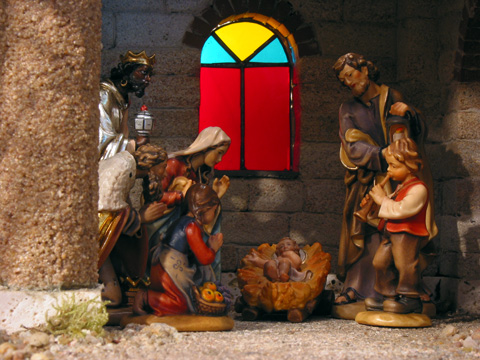|




PRESEPIO ROMANICO
ROMANISCHE KRIPPE
|
La traduzione italiana è in fase di elaboratione.
The Italic translation is under construction.
Die italienische Übersetzung ist in Arbeit.
Benutzen Sie bitte:
google translater
|
Egli è venuto in casa sua, e i suoi non lo hanno ricevuto, ma a tutti coloro che lo hanno ricevuto, egli ha dato l'autorità di diventare figli di Dio, a quelli cioè che credono nel suo nome,
Giovanni 1, 11
|
This nativity scene attempts to
portray two aspects of this "Nativity Message "
1.
The scene of the birth is set in front of or outside, the cloister
of a barely depicted romanic Church forming the background. It is
here outside that the King of the Jews, the Messiah, the Saviour,
Jesus is born. It is apparent that, despite brightly lit windows yet
closed doors, there is " no room in the inn" for the secretive,
silent and gentle coming of the Saviour!
Who is not reminded here of the words the resurrected one spoke to
the Church in Laodicea:
Here I am! I stand at the door and knock ....
Apocalypse 3, 20
2.
Time and again there is the chance of visiting one of these old Church
buildings, sitting in one of the pews, or standing in a ruin, admiring
the work of the builders.
And - if it is very quiet - almost able to hear the ancient hymns
and the praise of God, as sung by past generations, issuing from the
stones: monks and nuns singing in choir or the singing of the congregation
seated in the main body of the Church:
Laudate omnes gentes, laudate dominum - Praise
God, the Lord, all peoples, join in and praise the Lord.
This is a new hymn from Taizé based on Psalm 117 and sung to
a tune from Jacques Berthier.
It also a reminder of the ancient localities of Citeaux or Cluny.
Of Clairvaux or Clermont and many other european Churches, Cloisters
and Monastries.
This is also true of Bethlehem, Jerusalem, Nuremberg and the many
other places of this earth where for centuries shepherds and wise
men, children of God, have praised and worshipped Him, singing and
preaching His greatness in a variety of ways.
Nuremberg, the beginning of 2001
|
|
|





